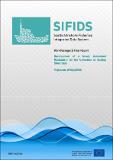Files in this item
Scottish Inshore Fisheries Integrated Data System (SIFIDS): Work package (3) final report development of a novel, automated mechanism for the collection of scallop stock data
Item metadata
| dc.contributor.author | Bates, C. Richards | |
| dc.contributor.author | Chocholek, Melanie | |
| dc.contributor.author | Fox, Clive | |
| dc.contributor.author | Howe, John | |
| dc.contributor.author | Jones, Niel | |
| dc.contributor.editor | James, Mark | |
| dc.contributor.editor | Ladd-Jones, Hannah | |
| dc.coverage.spatial | 95 | en_US |
| dc.date.accessioned | 2021-06-30T08:32:36Z | |
| dc.date.available | 2021-06-30T08:32:36Z | |
| dc.date.issued | 2019 | |
| dc.identifier.citation | Bates, C. R., Chocholek, M., Fox, C., Howe, J., Jones, N., James, M. A. (Ed.), & Ladd-Jones, H. (Ed.), (2019). SIFIDS Work package 3: development of a novel, automated mechanism for the collection of scallop stock data. Published by Marine Alliance for Science and Technology for Scotland (MASTS). 95pp. | en_US |
| dc.identifier.uri | https://hdl.handle.net/10023/23449 | |
| dc.description.abstract | [Extract from Executive Summary] This project, aimed at the development of a novel, automated mechanism for the collection of scallop stock data was a sub-part of the Scottish Inshore Fisheries Integrated Data Systems (SIFIDS) project. The project reviewed the state-of-the-art remote sensing (geophysical and camera-based) technologies available from industry and compared these to inexpensive, off-the -shelf equipment. Sea trials were conducted on scallop dredge sites and also hand-dived scallop sites. Data was analysed manually, and tests conducted with automated processing methods. It was concluded that geophysical acoustic technologies cannot presently detect individual scallop but the remote sensing technologies can be used for broad scale habitat mapping of scallop harvest areas. Further, the techniques allow for monitoring these areas in terms of scallop dredging impact. Camera (video and still) imagery is effective for scallop count and provide data that compares favourably with diver-based ground truth information for recording scallop density. Deployment of cameras is possible through inexpensive drop-down camera frames which it is recommended be deployed on a wide area basis for further trials. In addition, implementation of a ‘citizen science’ approach to wide area recording is suggested to increase the stock assessment across the widest possible variety of seafloor types around Scotland. Armed with such data a full, statistical analysis could be completed and data used with automated processing routines for future long-term monitoring of stock. | en_US |
| dc.language.iso | en | en_US |
| dc.publisher | Marine Alliance for Science and Technology for Scotland (MASTS) | en_US |
| dc.rights | Copyright © the author(s) / rights holder. This is the final version of the work. This work has been made available online with permission. Permission for further reuse of this content should be sought from the rights holder as identified in the PDF. | en_US |
| dc.subject.lcsh | Fisheries--Research | en_US |
| dc.subject.lcsh | Marine biology | en_US |
| dc.subject.lcsh | Oceanography | en_US |
| dc.subject.lcsh | Marine biology--Scotland | en_US |
| dc.title | Scottish Inshore Fisheries Integrated Data System (SIFIDS): Work package (3) final report development of a novel, automated mechanism for the collection of scallop stock data | en_US |
| dc.type | Report | en_US |
| dc.description.version | Publisher PDF | en_US |
| dc.publicationstatus | Published | en_US |
| dc.status | Non peer reviewed | en_US |
| dc.identifier.doi | https://doi.org/10.15664/10023.23449 | en |
This item appears in the following Collection(s)
Items in the St Andrews Research Repository are protected by copyright, with all rights reserved, unless otherwise indicated.

